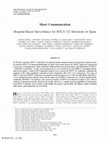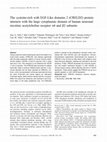Papers by Jose Ortiz Toro
People living with HIV/AIDS are stigmatized. Although personal and social consequences of this st... more People living with HIV/AIDS are stigmatized. Although personal and social consequences of this stigmatization have been documented, research regarding its impact on social interactions is scarce. Latinos, and Puerto Ricans in particular, have voiced concern regarding AIDS stigma. The authors investigated the key role of social interaction in the process of stigmatization through in-depth, semistructured interviews in a sample of 30 Puerto Ricans living with HIV/AIDS. Participants reported instances in which AIDS stigma negatively influenced social interactions with family, friends, sexual partners, coworkers, and health professionals. Some of the consequences they described were loss of social support, persecution, isolation, job loss, and problems accessing health services. Findings support the need for interventions to address AIDS stigma and its consequences.
Molecular Cancer, 2010
Background: Chemotherapeutic drugs like Adriamycin (ADR) induces apoptosis or senescence in cance... more Background: Chemotherapeutic drugs like Adriamycin (ADR) induces apoptosis or senescence in cancer cells but these cells often develop resistance and generate responses of short duration or complete failure. The methylxantine drug Pentoxifylline (PTX) used routinely in the clinics setting for circulatory diseases has been recently described to have antitumor properties. We evaluated whether pretreatment with PTX modifies apoptosis and senescence induced by ADR in cervix cancer cells.

Chemotherapy, 2006
Chemotherapy is effective against a wide variety of tumor cells, although its use is limited by s... more Chemotherapy is effective against a wide variety of tumor cells, although its use is limited by side effects. In vitro experiments and phase I and II trials have shown that phytochemicals such as perillyl alcohol (P-OH) have antitumor effects. Pentoxifylline (PTX), a synthetic methylxanthine used mainly to treat pathologies associated with hematological diseases, sensitizes tumor cells to chemotherapy. The aim of this study was to determine whether PTX amplifies the antitumor effects of P-OH in U937 human myelomonocytic leukemia cells. Apoptosis was measured by the loss of mitochondrial membrane potential determined by flow cytometry using dihexyloxacarbocyanine iodide (DiOC6) and propidium iodide. Bcl-2 and Bax protein expression was also assessed by Western blot analysis. P-OH and PTX induced loss of the mitochondrial membrane potential in U937 cells in vitro. Culturing the cells in the presence of both compounds caused a significant increase (p < 0.001) in apoptosis and expression of anti-apoptotic Bcl-2 and pro-apoptotic Bax proteins. However, despite their coexistence, Bax expression prevailed in our experiments. These data suggest that the effects of PTX might be attributable to changes in the mitochondrial membrane potential. PTX sensitizes tumor cells to the anti-neoplastic action of P-OH. These observations may have clinical relevance in the treatment of cancer patients.
Enfermedades Infecciosas Y Microbiologia Clinica, 2004
Cirugia Espanola, 2008
La rotura diafragmática derecha es un hallazgo poco frecuente y a menudo diagnosticado de forma t... more La rotura diafragmática derecha es un hallazgo poco frecuente y a menudo diagnosticado de forma tardía, ya que tiene relación con otros traumatismos de mayor importancia vital y una sensibilidad disminuida de las pruebas diagnósticas (tomografía computarizada). Debido a la concomitancia de traumatismos torácicos y hemoneumotórax, es habitual la realización de toracocentesis con tubos de drenaje.
Oncogene, 2000
We recently isolated a cDNA for hpttg, the human homolog of rat pituitary tumor transforming gene... more We recently isolated a cDNA for hpttg, the human homolog of rat pituitary tumor transforming gene. Now we have analysed the expression of hpttg as a function of cell proliferation. hPTTG protein level is up-regulated in rapidly proliferating cells, is down-regulated in response to serum starvation or cell confluence, and is regulated in a cell cycle-dependent manner, peaking in mitosis. In addition, we show that hPTTG is phosphorylated during mitosis. Immunodepletion and in vitro phosphorylation experiments, together with the use of a specific inhibitor, indicate that Cdc2 is the kinase that phosphorylates hPTTG. These results suggest that hpttg is induced by, and may have a role in, regulatory pathways involved in the control of cell proliferation.

Aids Research and Human Retroviruses, 2007
In contrast, HTLV-2 is found predominantly in native intravenous drug users (IDUs). Spain has exp... more In contrast, HTLV-2 is found predominantly in native intravenous drug users (IDUs). Spain has experienced a large wave of immigration, which could have influenced the current prevalence and distribution of HTLV-1 and HTLV-2 infection. A 1-day cross-sectional survey was carried out in May 2005 in 13 hospitals distributed across Spain. A total of 2873 outpatient subjects were screened for HTLV-1/2 antibodies. Although the majority of the study population consisted of native Spaniards, 206 (7.2%) were immigrants. Two cases of HTLV-1 and one of HTLV-2 infection were found (overall prevalence, 0.1%). The two individuals with HTLV-1 were immigrants from endemic areas and the single case of HTLV-2 infection was a former Spaniard IDU coinfected with HIV-1. In summary, the current prevalence of HTLV-1/2 infection in Spain is low, with no evidence of spread beyond the classical risk groups. However, a rapidly growing population of immigrants from HTLV-1-endemic areas in Spain could modify this pattern and periodic surveillance studies including both natives and immigrants are warranted.

Journal of Neurochemistry, 2005
Using a yeast two-hybrid screening we report the isolation of a novel human protein, hCRELD2β, th... more Using a yeast two-hybrid screening we report the isolation of a novel human protein, hCRELD2β, that interacts specifically with the large cytoplasmic regions of human nicotinic acetylcholine receptor (nAChR) α4 and β2 subunits, both in yeast cells and in vitro. This interaction is not detected with nAChR α7 and α3 subunits. The hCRELD2 gene encodes for multiple transcripts, likely to produce multiple protein isoforms. A previously reported one has been renamed as CRELD2α. Isoforms α and β are expressed in all tissues examined and have the same N-terminal and central regions but alternative C-terminal regions. Both isoforms interact with the α4 subunit. Within this subunit the interaction was localized to the N-terminal region of the large cytoplasmic loop. The CRELD2β protein is present at the endoplasmic reticulum where colocalized with α4β2 nAChRs upon cell transfection. Immunohistochemistry experiments demonstrated the presence of CRELD2 in the rat brain at sites where α4β2 receptors have been previously detected. Labeling was restricted to neuronal perikarya. Finally, CRELD2 decreases the functional expression and impairs membrane transport of α4β2 nAChRs in Xenopus leavis oocytes, without affecting α3β4 and α7 nAChR expression. These results suggest that CRELD2 can act as a specific regulator of α4β2 nAChR expression.

Aids Research and Human Retroviruses, 2009
HTLV-1=2 antenatal screening is not mandatory in European countries. The rapid increase in immigr... more HTLV-1=2 antenatal screening is not mandatory in European countries. The rapid increase in immigrants coming from areas endemic for HTLV-1 infection has compelled a review of this policy in Spain. From February 2006 to December 2007, a cross-sectional study was carried out in all pregnant women attended at 10 different Spanish hospitals. An enzyme immunoassay (EIA) was used to test serum HTLV-1=2 antibodies; reactive samples were further confirmed by Western blot and=or polymerase chain reaction. A total of 20,518 pregnant women were examined, of whom 18,266 (89%) were native Spaniards. Overall, 946 (4.6%) of the immigrants came from HTLV-1 endemic areas (mainly Central and South America and sub-Saharan Africa). Four samples were EIA seroreactive for HTLV-1=2, two of them in women infected with HTLV-1 coming from endemic areas. The other two women were infected with HTLV-2; one was an immigrant from Bolivia and another was a native Spaniard who admitted prior injection drug use and was HIV-1 positive. The overall HTLV-1=2 seroprevalence was 0.19 per 1000 (95% CI: 0.05-0.49=1000). For HTLV-1, the seroprevalence was 2.11 per 1000 (95% CI: 0.26-7.62=1000) in pregnant women from endemic areas. The seroprevalence of HTLV-1=2 infection is below 0.02% among pregnant women in Spain, and therefore universal screening for HTLV-1=2 infection in antenatal clinics is not warranted. However, HTLV-1=2 screening could be considered in pregnant women coming from endemic areas, in whom the rate of infection is nearly 1000-fold higher than in native Spaniards and are the only group infected with the more pathogenic HTLV-1.
Apreciable Ingeniero: Por este medio, me dirijo a usted intonnándole que he revisado el Intonne F... more Apreciable Ingeniero: Por este medio, me dirijo a usted intonnándole que he revisado el Intonne Final de Trabajo de graduación titulado "DISeAo, CONSTRUCCiÓNy EVALUACiÓNDE UN REACTOR FLUJO PISTÓN DE FORMA HELlCOIDAL ESCALA LABORATORIO", preparado por el estudiante Diego Bernardo Lainfiesta López, quien se identificacon el carné No. 2004-12725.





Uploads
Papers by Jose Ortiz Toro